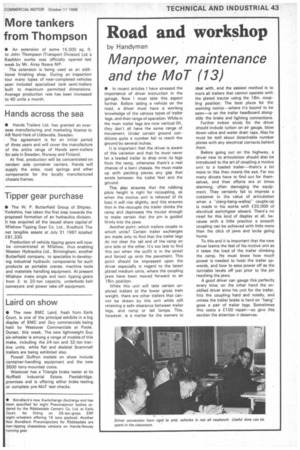Road and workshop
Page 45

If you've noticed an error in this article please click here to report it so we can fix it.
by Handyman
Manpower, maintenance and the MoT (13)
• In recent articles I have stressed the importance of driver instruction in the garage. Now I must take this aspect further. Before taking a vehicle on the road, a driver must have a working knowledge of the various types of trailer legs, and their range of operation. While in the main trailer legs are now vertical lift. they don't all have the same range of movement. Under certain ground conditions quite a number fail to reach the ground by several inches.
It is important that the driver is aware of this variation and that he must never let a loaded trailer to drop onto its legs from the ramp, otherwise there's a real chance of a bent chassis. He must make up with packing pieces any gap that exists between the trailer feet and the ground.
This also ensures that the rubbing plate height is right for recoupling, as when the motive unit is relieved of its load it will rise slightly, and this ensures that in the recouple the trailer climbs the ramp and depresses the tractor enough to make certain that the pin is guided firmly into the jaws.
Another point: which trailers couple to which units? Certain trailer exchanges are made only to find that the trailer legs do not clear the tail end of the ramp on one side or the other. It's too late to find this out when the outfit is in the street and forced up onto the pavement. This point should he impressed upon the driver especially in regard to the latest plated medium units, where the coupling jaws have been moved forward to an 18in. position.
While this unit will take certain unplated trailers at the lower gross train weight, there are other trailers that cannot be drawn by this unit while still retaining a safe clearance between trailer legs, and ramp or tail lamps. This, however, is a matter for the owners to deal with, and the easiest method is to mark all trailers that cannot operate with the plated tractor using the 18in. coupling position. The best place for the warning notice—where it's bound to be seen—is on the trailer headboard alongside the brake and lighting connections.
Further indoor study for the driver should include tuition on air gauge, blow down valve and water drain taps. Also he must be told about detachable number plates with any electrical contacts behind them Before going out on the highway, a driver new to articulation should also be introduced to the art of coupling a motive unit to a loaded trailer—there's a lot more to this than meets the eye. Far too many drivers have to find out for themselves, and their efforts are at times alarming, often damaging the equipment. They certainly fail to impress a customer in the value of articulation when a "clang-bang-wallop" couple-up is made in his works with £20,000 of electrical switchgear aboard. There's no need for this kind of display at all, because with a little practice a smooth coupling can be achieved with little more than the click of jaws and locks going home.
To this end it is important that the new driver ieams the feel of his motive unit as it takes the load of the trailer climbing the ramp. He must know how much power is needed to hoist the trailer upwards, and how to ease power off as the turntable levels off just prior to the pin reaching the jaws.
A good driver can gauge this perfectly every time on the other hand the unskilled driver aims his unit for the trailer, hits the coupling hard and noisily, and unless the trailer brake is hard on "bang" goes a pair of trailer legs. Sometimes this costs a £100 repair—so give this section the attention it deserves.












































































































